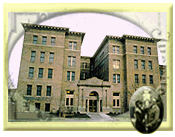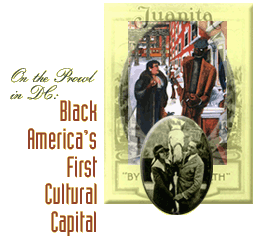 |
 |
 |
|
|||
On the Prowl in DC:
Black America's First Cultural Capital

This area is called Shaw. It's a neighborhood in Washington, D.C. that was not only the birthplace and home of Duke Ellington, but is cited by historians as the cultural capital of black America before the Harlem Renaissance. It attracted great jazz musicians like Louis Armstrong and Ella Fitzgerald, and nurtured important African American cultural and political leaders including Supreme Court Justice Thurgood Marshall, and poets Paul Laurence Dunbar and Langston Hughes. Though the Shaw neighborhood is less than a mile from the White House, most visitors to Washington don't make it here -- and most likely because they don't know about it. But it's a dynamic community that enjoyed an astounding heyday from the 1920s to the '60s, as Historian Edward Smith describes.
Ironically, it was forced segregation that initially created the cohesion in this community. And, likewise, the end of legal segregation led to its decline. By the early 1960s, after the Equal Housing Act had been passed by Congress, many of Shaw's middle class residents began to leave for the suburbs, opening up the area to people of lesser means who were not as dedicated to the community. By 1968, the neighborhood had all but fallen apart after suffering the terrible riots that followed Martin Luther King's death. 
But over the past decade, Shaw has experienced a remarkable renaissance with money being put into new shops, restaurants, and, most importantly, the renovation and reconstruction of many of its historic landmarks. One such place is the Lincoln Theatre on U Street, which was the back drop for scores of performers throughout the century.
Jocelyn Russell is executive director of the Lincoln Theatre, the sole remainder of the many grand venues that Shaw once offered.
The theater was dark for many years and risked demolition. But in 1994, after an $8 million renovation, the city once again opened the doors of the Lincoln Theatre. Now adorned with ornate wallpaper and spectacular gilded ceilings, it entices visitors of all ages with its diverse offering of programs.
Another popular stop on U Street ' and right next door to the Lincoln Theatre -- is Ben's Chili Bowl.
I figured, anything that makes a hot dot bark, I gotta try, so I took my place on a red barstool at the counter and ordered up a bowl. While I waited, I had a chance to talk with Nizam Ali, son of owners Virginia and Ben himself.
As the photographs on the walls reveal, the customers range from neighborhood folk to people like Bill Cosby and Denzel Washington. And according to Nizam, it's always been this way.
And no matter who does walk in the door, you can bet they're going to savor whatever they order -- I know I did!
Just a block down U Street from Ben's Chili Bowl is the nightclub Republic Gardens, which first opened in the 1920s. But, like most places along this corridor, it stood empty for many years until it reopened seven years ago. Co-owner Mark Barns doesn't bring much attention to the history of the place, but instead tries to keep the original spirit of U Street alive in the way he runs the club.
And that's what resonates after a visit to Shaw. You leave, having experienced a vibrant community that has come full circle from near demise. And its revival is built on the foundation of its history. So whether you like to spend your time in a nightclub, at the theater, enjoying a great dining experience, or simply strolling the streets, this neighborhood offers a lot -- and is not far off the very beaten path of the nation's capital. For information about tours of U Street, you can call the Manna Community Development Corporation at 202.232.2915. Also, you may want to keep your eyes open for the upcoming PBS documentary about Shaw called "Duke Ellington's Washington." It premieres nationwide on Monday, February 7th as a feature of Black History Month. This segment was produced by Molly Murphy.
|
 | American Public Media Home | Search | How to Listen ©2004 American Public Media | Terms of Use | Privacy Policy |


